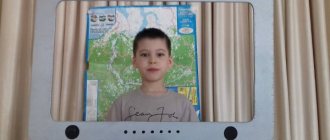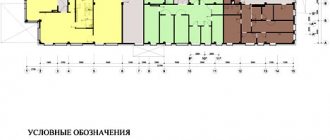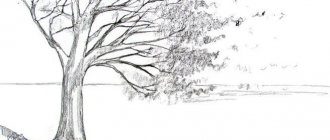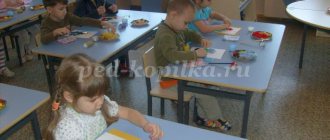Summer walk - excursion in kindergarten. Middle group
Summer fun at a preschool educational institution. Excursion to flower beds
The excursion is intended for children of middle and senior preschool age.
The teacher conducts it during a walk in the summer, but it can also be included as part of a lesson on familiarization with the natural world. Preliminary work: To consolidate the sequence of flowering of plants in the flowerbed, from April to September, a herbarium is created together with the children (dried flowers are glued to a sheet of paper in the order of their appearance) Goal : to activate children’s interest in the world around them, to systematize children’s knowledge about a specific flower - the daisy. Objectives: to evoke in children a positive emotional response to the beauty and diversity of the flower world; Teach children to compare, find common and distinctive features of colors. Develop thinking, observation, memory, and the ability to make inferences. Reinforce knowledge of the names of summer months and flowers. Preliminary work : work in the flower beds on sowing and caring for flowers, asking riddles about flowers, looking at pictures of flowers, getting to know their names.
Excursion progress
Educator: Children, tell me, is it beautiful near our kindergarten? (children's answers) - What especially decorates the territory of the kindergarten now, in the summer? (children's answers) - That's right, flowers. Let's take a tour of the kindergarten territory today and admire the beauty and diversity of the flower world.
What are the names of the places where our flowers grow? - That's right, flower beds. Our kindergarten is decorated with beautiful flower beds with various flowers. Many flowers are familiar to you, I’ll tell you about some today. Educator: Children, flowers are a symbol of happiness, kindness, beauty. Therefore, often, when you want to do something nice for a person, they give him flowers. So today I would like to give you a gift. Admire them, look at them more closely, you can even touch them, smell them, but don’t tear off such beauty, and then we will reflect your impressions in the drawings. (Children admire the flowers, some touch, look at, smell)
Educator : What time of year is it now? Name the summer months What month is it now? Now name the flowers that bloom in July. And a hint for you in our flower beds. (rose, chamomile, marigolds, calendula...) Educator: Tell me, why do the flowers bloom so beautifully in our flower beds? But in the forest the flowers are not so large.
Children: they take care of flowers in flower beds, but not in the forest. Educator : Yes, it’s correct that the flowers are large, you can clearly see them in the flowerbed, they need to be looked after. Let's remember how we did it. Children: Digged the ground, sowed seeds or planted seedlings, watered when the ground was dry, loosened the soil, weeded out weeds. Educator: The little sisters are standing in the flower beds: They have a golden eye, white eyelashes. What flower is this that I asked you a riddle about? Children: Chamomile.
Educator: Do we have chamomile in our flowerbed? Children pay attention to daisies Educator: What does this flower look like? Children: To the sun with rays Educator: Yes, chamomile is always compared to the clear sun. In our country, chamomile is a symbol of purity and kindness. There are many types of chamomile in nature, but the most famous are odorless chamomile (shows) and chamomile (shows). Chamomile flowers have amazing healing properties. Decoctions and infusions from it are used in medicine. Previously, this flower was called “Romanov flower”, over time people began to affectionately call it “daisy”. But scientifically this flower is called “nivyanik”. (Children repeat the name) Educator : Let's look at this little sun and talk about its structure. Children: Tall straight stem covered with long green leaves. The flower is held in the ground by its roots. The flower itself consists of many white petals and a yellow center. After smelling the flower, children say that garden chamomile or cornflower has no smell. Educator : Garden chamomile is an odorless plant, but it attracts insects with its color. Flying from one flower to another, flies, bees, butterflies and other insects carry pollen. (The teacher draws the children’s attention to echinacea and rudbeckia) Children, look, we still have flowers that look like daisies growing in our flower beds. Can we call them daisies too?
Indeed, these flowers look like daisies, call them what? Children: Flowers also have many petals, like a chamomile, there is a middle, a tall stem, and long leaves. Educator : That's right, these flowers are similar, but what is the difference? Children: These daisies (points to the echinacea) have pink petals, and the middle is brown, but these (points to the rudbeckia) have yellow petals, with brown spots in the middle, and the middle is also brown.
They also differ in the shape of their green leaves, and their trunks are hard and rough. (children examine the stems of these plants by touch) Educator: A plant with pink petals is called echinacea (Children repeat the name). Like chamomile, it has healing properties and is also used in medicine. If you have a sore throat, a decoction of echinacea will help, if you hurt your knee, wash the wound with the same decoction. It strengthens our body well if we use medicines and vitamins with this plant. Educator: A plant with yellow petals is also called rudbeckia. (Children repeat the name) Educator: What is the name of an ordinary garden chamomile? Children: Nivyanik Educator: Chamomile is a flower dear to the heart, kind, gentle, heartfelt, which decorates our lives, gives joy and health to a person. A small sun on my palm - A white daisy on a green leg, Yellow hearts with a white rim. There are so many of them in the meadow, how many of them there are by the river... Educator: Let's once again admire the beautiful decoration of our flower beds, the abundance of flowers. And I suggest you decorate the asphalt paths with flowers.
Draw on the asphalt those flowers that you especially like and then our kindergarten will be covered in flowers. The teacher distributes colored crayons to the children. Children draw flowers on the asphalt.
A soundtrack of children's songs will play.
We recommend watching:
Fairy tale day in kindergarten in the middle group in the summer. Scenario Summary of an integrated lesson for children of the middle group on the topic “Summer” Summer entertainment in the middle group of kindergarten. Journey to the Land of Flowers Plan of summer health work in the middle group, taking into account the Federal State Educational Standard
Similar articles:
Summer in kindergarten
Scenarios for summer holidays and entertainment in kindergarten. Middle group
Walk watching the sun in summer. Senior group
Walk watching the clouds. Middle group
Observing insects in the older group in summer
Online kindergartens
Online kindergarten Win-Win Kids
Age : 3-4, 5-7 years Website : https://www.winwin-kids.com Phone : +79251227869, +74957409446 Cost : 5000 rub./week
In the online kindergarten you will find:
- Daily group classes
- Homework with different levels of parental involvement
- Individual consultations with parents by appointment
- Reading books specially selected by professionals in two languages
- Individual lessons for children by appointment
The program includes classes and master classes in the following areas:
- English
- Creativity
- Cooking
- Reading
- Experiments
Online mini-garden “House of Wizards”
Age : 3-7 years Website : https://volshebniki-online.ru Phone , +7 (925) 656-75-54 Cost : first day - free, 1 day - 600 rubles, 1 week - 2000 rubles, 2 weeks - 3500 rub., 4 weeks - 6400 rub.
On weekdays there are 2 lessons in different areas + time for communication. 2 age groups: 3-4 years and 4.5-6 years.
In the afternoon, children receive fun video assignments. You will also get access to a library of video lessons that you can play for your child in his free time.
Classes:
- English language
- Rhythm and dancing
- Speech development, creativity
- Music and singing
- Mathematics, crafts
To conduct classes you need a laptop or computer with a web camera and the Zoom program. For creative activities you will also need: plasticine, colored pencils, markers and plain paper.
Online kindergarten KIDVILLE
Age : from 4 to 7 years Website : https://kidville.ru Phone Cost : free trial lesson, day - 1000 rubles, week - 4000 rubles, English - 400 rubles / lesson
The child will be busy with his development for 2 hours a day - online classes are held daily in a mini group of up to 6 children via live broadcast.
Rates:
Day
- 3 developmental classes in an online group
- Games, songs and communication between children
- A selection of master classes, audio fairy tales and activities to keep your child busy after classes in online kindergarten
A week
- 5 days a week 3 developmental classes in an online group
- Games, songs and communication between children
- A selection of master classes, audio fairy tales and activities for children after classes in online kindergarten
- Individual diagnosis of child development by a teacher
English
- English with a native speaker 45 minutes in a mini group
- Without translation into Russian
- Games and songs to help memorize vocabulary
Consultation for teachers “Walks and trips outside the kindergarten territory”
Tourist walks, hikes and expeditions can have different purposes:
* wellness (hardening, gaining a reserve of vigor and performance, emotional and psychological recovery);
* sports training (physical training, training in overcoming natural obstacles, terrain orientation, tactics in extreme situations);
* educational (studying the native land, getting to know its historical and natural attractions);
* entertaining (games, competitions, competitions of nature experts, hiking songs, etc.);
* aesthetic (artistic and creative activities in nature: drawing, writing, etc., communication with friends).
The goals of walks can be combined, combined in different ways, or can be defined as the main and only ones. Depending on the main purpose, tourist walks with preschool children are divided into different types.
Having brought the children to the place of the excursion, you should remind them of its purpose in a short conversation and let the children look around. The main part of the excursion is collective observation, with the help of which all the main tasks of the excursion are solved. The teacher must help children notice and understand the characteristic signs of objects and phenomena. To do this, you can use various techniques: questions, riddles, comparisons, survey activities, games, stories, explanations. The level of cognitive activity is facilitated by elements of conversations and logical tasks offered by educators. An example is the question: “How is the birch tree in the park similar to the birch tree on your site? ", etc. It is advisable to use those that stimulate the expression of children's emotions and feelings. You can ask your students what kind words you can give to the flowers in the flower beds of the park, what wishes you can send to your feathered friends, etc. It is necessary to pay attention not only to individual natural objects, but also to ecological communities, considering the “floors” of the park and reservoir , defining the conditional interaction between them, building logical chains of connections and dependencies.
Didactic games conducted during excursions should be focused on providing preschoolers with the opportunity to demonstrate an active, environmentally literate position in relation to natural objects. Topics can be the following: “Help the tree”, “Be careful, ant”, “Birds love silence”, “Good morning”, etc.
Small environmental actions expand the experience of environmental protection activities, support the desire to actively and independently provide assistance to natural objects, and allow you to experience a sense of pride from the work performed. During excursions to a square, park, or pond, children, together with adults, can hang bird feeders, plant grown seedlings in flower beds and flower beds, plant trees, etc. The most significant thing is that during these activities, preschoolers accumulate emotionally positive communication experience with nature.







